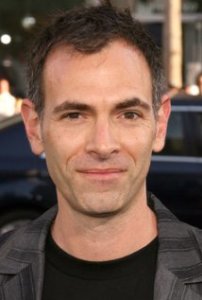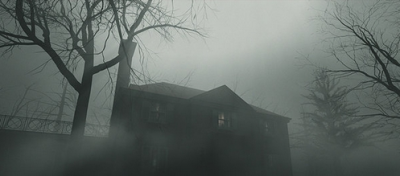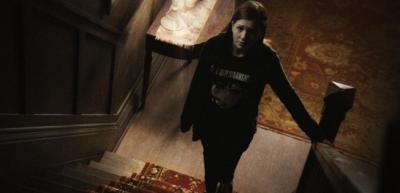By: debbie lynn elias
With HAUNTER, director Vincenzo Natali brings us an honest to goodness, goosebump inducing, arm & neck hairs standing on end, thrills & chills fright that even had me jumping a bit with those noises and sudden haunting whispers. A good old fashioned haunted house ghost story with a twist, HAUNTER is hauntingly chilling. Toying with the idea of life after death and eternal suffering a la Groundhog Day, with HAUNTER, Natali plays with the mind and turns the typical ghost/haunted house story on its ear, creating nothing short of an enthralling emotional and visceral experience.
Not someone you might expect to deliver such grand fright with things that go bump in the night, and beyond, Natali’s background is that of animation. Yes, animating for Nelvana Animation Studios and doing storyboards for favorite children’s animated series like Babar, Rupert, Beetlejuice and Fievel’s American Tails. But along the way, Natali stepped away from the fantasy and color of a child’s world and stepped into the adult world of horror, writing and directing films like Cube, Splice, Cypher and now, HAUNTER.
I had a chance to speak with Vincenzo Natali in this exclusive interview, discussing these very different worlds, but particularly the world of HAUNTER.

First thing I must do is compliment, commend and thank you for HAUNTER. This was a wonderfully emotional and visceral experience watching this film. Everyone has this preconceived notion that scares and frights come with hacking and slashing but that’s not the case and that is more than evident with HAUNTER. You play with the mind. You turn a ghost story on its end. It’s so wonderfully done.
Thank you so much, debbie. I really appreciate that. You nailed it! That’s what we wanted to do.
I left the screening room and I was nuts over the film. We don’t see much today that really plays on the imagination. Directors want to force-feed and spoon-feed us with everything but you create this great ambiguity and leave so much for our own imaginations to latch on to and run with.
Thank you. That was a goal of mine.
What was the appeal of this particular story when it came to you? I know you had previously worked with Brian King on Cypher. I also find it very entertaining that you come out of animation background where you were storyboarding cute little Babar the Elephant and now we’re seeing you directing a film like HAUNTER.
[laughing] I know. It’s disturbing to think that someone like me would be allowed to work in children’s television but, it’s true!

So, how did this come to you with Brian and what was the appeal of this particular script?
It appealed to me on many levels. First and foremost, it’s a very emotional, thoughtfully constructed puzzle of a movie. I was entirely engrossed by it when I read it the first time. It deals with a lot of themes that I have been obsessed with over the years. On one level it’s about adolescence. It’s about how when we’re teenagers we see the world one way and we know the truth about the world but our parents are entirely blind to it. That’s exactly who Lisa is; somebody who, in her case, knows that she’s dead, knows that her family is dead, but as far as they are concerned, they are just enjoying a happy rainy Sunday afternoon together; nothing is at all wrong. It is that duality that really fascinated me. Then it’s also a film that is very much about family. I really responded to the connection that Lisa makes both with her family and then with Olivia’s family. There’s this kind of, I don’t want to call it a love affair, but there’s this very emotional connection between this girl who’s alive and this girl who’s dead. The movie is kind of an onion-layered film. Everytime I read it I would peel away another layer and see something else.
One of the things that you do expose and address in HAUNTER is the fragmenting of the father figure. We are so ingrained through books and films and television that the father figure is still the head of the household, all powerful, kids run to daddy, daddy will have answer. Here, that myth gets torn down.
There’s definitely some Freudian stuff going on! The moments that I really enjoyed in the script were frequently the ones where on its face everything seems perfectly normal and the family is having this kind of perfect suburban day together, the most wholesome kind of meal together, yet you know under the surface something truly disturbing is lurking. That, of course, is connected directly to the father. It evolves over time. I think it’s unusual for a horror film to be as emotional as this movie is.
There’s so many layers and such emotional complexities here.
There really are. It’s funny because the film becomes surprisingly sweet and that’s not something I’m accustomed to in my own films but I thought that was a surprisingly rewarding turn. Lisa as a character starts off as somebody who feels hard-done by and disconnected from her family and then gradually as this puzzle begins to reveal itself, she puts the pieces together, she becomes more connected to them. Having just had a little boy myself, I really felt for them.

HAUNTER is contained, self-contained, within what is the Johnson house; be it through the various eras on the temporal plane, but it’s still that one house. Is that more challenging or freeing to you as a director when you’re developing your tonal and physical construct?
It’s a funny thing because nothing would frighten me more than a blank page or a blank check. As much as I would like to have more resources to make my movies, invariably I’m grateful for the restrictions I have to work with because they make me more creative. It’s that kind of friction between trying to do a lot with a movie and having very little to do it with that often gives you the best result. One of the things that was so brilliant about Brian’s script is that he set it entirely in this house and yet as we gradually discover, this house is unto itself, a kind of universe and there are all kinds of strata of reality that coexist in this one space. That’s just an exciting thing conceptually. From the point of view of visually portraying that, it’s exciting because you get to explore that environment with a kind of fine tooth comb and in a way that you wouldn’t if you were blazing from one location to another. It’s like a symphony where you have one theme and you’re endlessly creating variations on it and therefore, in some ways, you can become more baroque and outrageous and creative in the way that you show it. I’ve done a number of things that are like this. In some ways I feel like it’s more inspiring that working with a really big canvas.
You bring in Jon Joffin as your cinematographer. I love his work. He tackled one of the seminal time tesseract children’s books of all time, A Wrinkle In Time, and did a beautiful job with that so I was very excited when I saw that he was working HAUNTER with you. I was waiting for decades for that book to be turned into a film and although it ended up as a tv movie, I was so pleased with what Jon did – they go through the temporal plane transport with different locations, same locations – and to see him do that here on a smaller scale, I was thrilled because I knew what he could do with it.
That’s so neat! I’m gonna tell Jon that. It will make him very happy. That’s so great. Jon did magnificent work and it was very important to us that we make the film beautiful, aesthetically beautiful. I always feel that way with horror. I want to see something that’s unnerving and disturbing played out in a very beatific setting and light. He really created an atmosphere. If you make a haunted house film which HAUNTER is, it’s all about atmosphere; everything lives and dies by that. And it’s a very intimate kind of horror film. The other thing that Jon did beautifully, I felt, was light the faces as if they were a landscape. A lot of the movie is about faces.
The lighting of the faces is so important here because it’s the expressiveness or the lack thereof to convey tone and emotion, especially with Stephen McHattie. That lighting on his face in the different scenes is brilliant, simply brilliant.
I’m so glad you pointed that out. I think that far too often the contribution of somebody like Jon is overlooked and I think it’s paramount to the success of the movie. We worked very hard to always put the faces in a half-light. There’s always this sense that we’re only seeing part of what’s there. He’s very precise, very meticulous DP.
Even in the attic scenes with Abigail Breslin in character as Lisa, you’ve got the light overhead and she tilts her head up – the face is still in a half-light with the mouth and chin area. We just get the eyes really lit showing us the fear in her eyes. Very nuanced and very beautifully executed.
Thank you. Thank you. I wanted to focus on the subtleties of this movie. I know when Brian wrote the script it was very much in response to the kind of torture-porn horror that was being down about five years ago and he wanted to do something that was very lyrical and elegant. A lot of the fun of it was just getting those nuances right.

Another nuance that you have in here that jumped out at me is when Lisa goes back in time to the read period of the house in the 1920’s. You’ve got the visuals lensed like an old 16mm film and as she’s going back in time, your sound design is so meticulous and specific that we can actually hear the clicking of the frames as the sprockets are going through the projector.
It was really fun to do that. It was important that each era be portrayed in a very distinct and unique way. The primary time period we’re in is the mid-1980’s which is when Lisa and her family were killed. That was painted in very warm tones. When we go into the present, we actually wanted to treat it sort of from Lisa’s point of view so it’s almost like going into a science fiction film and the lighting becomes much harsher and cool, somewhere between sci-fi and reality tv – much more immediate. Whereas when we go back into the 1920’s, there’s this kind of patina of an almost George Melies or a silent movie. That’s what I mean by variations on a theme. It was really fun to re-examine that same space through these different lenses.
Going back to the 1920’s sequence, felt like I was watching the Sunday Night Silents on TCM. So glorious and immersive.
[laughing] Oh, thank you. It was fun because when you have opportunities like that we can get quite experimental. I’m glad you pointed out the sound design, too. We put a lot of work into creating an aural architecture to the movie that evolved in tandem with everything else. The guy who cut the sound for that really did some very interesting, avant-garde things.
Between the ethereal sounds of Olivia or somebody from the past, you get high-pitched subtlety; nothing is banging you over the head but for loud thumps. Then the sound of the car engines changes from era to era and the walkie-talkie that Robbie has. It’s all very intricate and very distinctive.
I’m pleased you picked up on that.
One last question for you Vincenzo. What did you personally take away from the experience of making HAUNTER?
That’s a hard question to answer because I never know the answer until years later. It still feels fairly recent to me but I think I learned a lot about, oddly enough, relationships. I would say that of all the films that I’ve made, it’s the most overtly emotional one. If the film is a success it’s because of the emotional journey that Lisa has. I like to think that I’m in control of my destiny, but it’s becoming very apparent to me that I have zero control.
Are you working on anything else right now?
I’m doing some television work right now and I produced my own tv series this summer, a thing called Dark Net which is cable-internet hybrid which is going online on Halloween day!
Thank you so much and thank you for HAUNTER. A haunting delight.
You made my day, debbie!
#
10/9/2013












